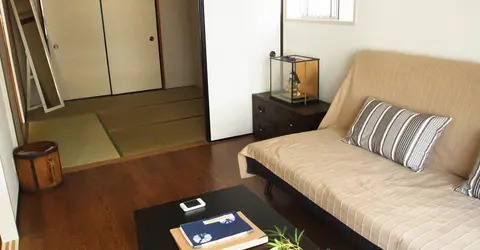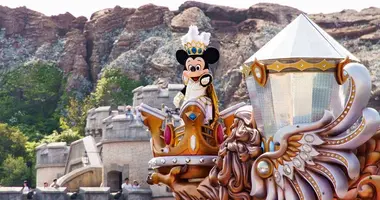Tokyo National Stadium
- Published on : 24/12/2012
- by : Japan Experience
- Youtube
Tokyo National Stadium: Prince Chichibu Memorial Sports Museum in Kasumigaoka National Stadium, Tokyo
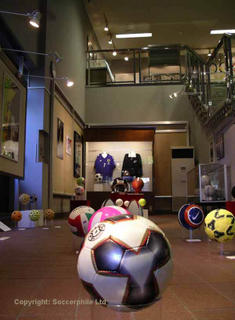
Tokyo's Kasumigaoka National Stadium is a graceful 56,000 capacity stadium and host for numerous national sporting events and cup finals.
Built in 1958 for the 1964 Tokyo Olympics, Tokyo National Stadium replaced what was the Meiji Jingu Gaien Athletic Stadium.
Set in tree- & cafe-lined Sendagaya near the Chuo-Sobu Line station of the same name, it is at about '5 o'clock' of the massive Shinjuku Gyoen Park, a little south-east of the central business district of Shinjuku, whose towers are clearly visible.
On the ground level of the stadium, to the left after entering the main Setagaya gate (the gate nearest Kokuritsu-kyougijo subway station), is the Prince Chichibu Memorial Sports Museum. It is in memory of Emperor Hirohito's brother, Prince Yashuhito Chichibu, known in Japan as the Sportsman Prince. With an association this distinguished, the museum is far from being an afterthought. It was opened in 1959, only a year after the completion of the stadium. It is an attraction in its own right for any sporting enthusiast. The museum takes up two levels: the first level, however, being little more than the reception desk and a display foyer featuring the theme of whatever special exhibition is underway. (See photo above.)
Having been built for the Olympics, the permanent display centers around the ongoing story of the world's greatest sporting event. The first exhibit which you reach on ascending the stairs to the main exhibition rooms is The Olympic Games and Japan'. There is a scale model reconstruction of ancient Olympia, statuary related to the original Olympics, and an introductory background, replete with memorabilia, of the first 1896 modern Olympics.
Exhibits include Olympic torches from a number of games, old uniforms - including those of some of the very first Japanese Olympic athletes, posters, medals, mascots, commemorative goods, photographs, tickets and medals.
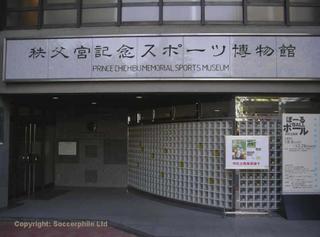
Move on and the walls of the first room are dominated by a massive media display of the saga of the modern Olympics, with an outline and ample pictorial representation of each Games in succession as you move along.
Having been built specifically for the 1964 Tokyo Olympics, the games of that year are best represented amongst the realia. Gold medals on display from those games are especially noteworthy. A knowledge of Japanese would enhance the experience, but the expert presentation and the wealth of related exhibits in the room's central display cases make for fascinating viewing even without access to the written details.
There are several more display rooms that move on to cover first the winter Olympics and then the History of Modern Japanese Sports'. One display case is dedicated to traditional Japanese sports: yabusame (horseback archery), kemari (a form of football traditionally played by priests), Japanese polo & field hockey, sumo and little known traditional Japanese weightlifting, with a hefty 'chikaraishi' (literally 'strength rock') on display.
However, most of this section displays a wide range of sports paraphernalia including soccer and other balls, pucks, saddles, bats, rackets, masks, shoes, trophies, uniforms, and photographs.
One particularly memorable section is The Sports Arts', full of posters, drawings, statuary, and photographs, including a team photo of a touring New Zealand rugby team from 1967.
On the way to the (final) special exhibition you pass by a mini theater, of course in Japanese - but worth tarrying for a few minutes for some landmark moving sports footage.
The special exhibition at the time of writing (Oct 2005) was ball sports. The special exhibition is accessible down a display corridor decked out with exhibits reflecting the theme: this time, balls. The display had its own very personable curator, took up three large rooms, and had an information stand with various pamphlets of numerous sports organizations on offer. The display rooms themselves were full of a breathtaking array of balls ranging from golf and table tennis balls to giant kin-balls, from old leather balls to high tech plastic ones, from the old beige soccer balls of yore to hi-tech acid-hued modern ones. Best of all, it was interactive, the curator even encouraging me to 'please touch the exhibits'!
As mentioned above, presentation of the exhibits is mainly in Japanese. However, numerous captions have been translated and there is as much, if not more, in the way of images and realia as there is of commentary. Anyway, aren't museums more about looking (and, at this one, touching) than reading?
The Stadium is also home to a related sports library with about 30,000 books and a collection of over 60,000 (mainly Japanese) sports periodicals.
Finally, visitors are invited to enter the stadium itself and look around, except on the day of events.
The stadium's governing body is the public corporation, The National Agency for the Advancement of Sports and Health (NAASH).
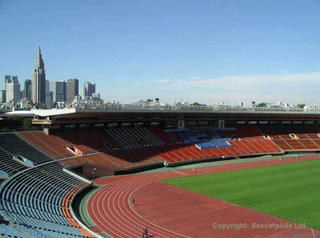
Prince Chichibu Memorial Sports Museum
10-2 Kasumigaoka
Shinjuku-ku,
Tokyo 160-0013
Access
5 minutes walk from Sendagaya Station on the JR Chuo/Sobu line.
2 minutes walk from the Kokuritsu-kyougijo on the Toei Oedo Subway Line.
Museum hours
9.30 am - 4.30 pm (last entry 4 pm)
Closed 2nd and 4th Tuesdays of the month, and at New Year.
Library hours
9.30 am - 4.30 pm (last entry 4 pm)
Closed Saturday, Sunday and national holidays.
Entry fee: 300 yen for adults, 100 yen for students. Discount available for groups of 20 or more.
Guide To Tokyo Metropolitan Area
Books on Tokyo Japan
Kasumigaoka National Stadium. Read a guide to Tokyo's Kasumigaoka National Stadium, a graceful 56,000 capacity stadium and host for numerous national sporting events and cup finals.


